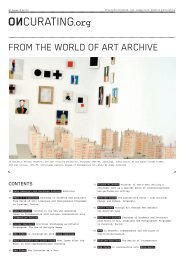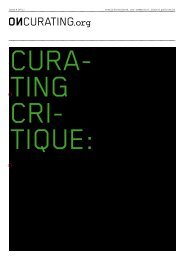You also want an ePaper? Increase the reach of your titles
YUMPU automatically turns print PDFs into web optimized ePapers that Google loves.
066 Issue # 11/11 : PublIc Issues<br />
these works but we don't mention them and don't list them<br />
in our résumé.<br />
Derya: Another question would concern the issue of child<br />
labour in relation to your work One Day in Oda (this<br />
issue h<strong>as</strong> also been raised by Rachel Haidu). Could someone<br />
detect therein an example of exploitation – in the c<strong>as</strong>e<br />
of Nurs¸en's labour, I mean? This question could also be<br />
raised in relation to Claire Bishop's comparison between<br />
Hirshhorn and Oda Projesi. In her article in October,<br />
Bishop discusses the same thing with reference to Santiago<br />
Sierra. It sounds <strong>as</strong> if for Bishop Sierra and Hirschhorn<br />
are more honest since they paid those who contributed<br />
to their projects. And in her analysis, projects b<strong>as</strong>ed on<br />
collaboration, including Oda Projesi, only pretend to<br />
integrate participants into the process. A sound discussion<br />
about Oda Projesi first requires considering everyday<br />
life in Istanbul, the way in which people in Galata relate<br />
to each other, and so on. As a matter of fact, Bishop<br />
talks about "the aesthetic regime of art ... <strong>as</strong> we under-<br />
stand it in the West" (Bishop 2006, p. 183). Thus, she<br />
adopts what she calls a Western-centric perspective, and<br />
this perspective prevents her from seeing some of the<br />
local specificities in Oda Projesi's work. What would you<br />
say about this?<br />
Günes¸: What I can say about the issue of child labour is<br />
this: I guess what differentiates the c<strong>as</strong>e is the bracketing<br />
of what will normally be considered daily experience.<br />
When I share the video recording of the half day I spent<br />
with Nurs¸en, something strange happens. And it becomes<br />
even more complicated because she is a child. It w<strong>as</strong> such<br />
a long time ago; even I am struggling to reflect upon the<br />
c<strong>as</strong>e now. At that time, what mattered to me w<strong>as</strong> to share<br />
things with her and to create a temporal space for<br />
her. But now, even I find it odd to have shared the video<br />
recordings with others and to have signed them <strong>as</strong> Günes¸<br />
Sav<strong>as</strong>¸. But I can also add that my main intention at the<br />
time w<strong>as</strong> definitely not to add these works to my résumé.<br />
I guess I did it under the influence of my previous art<br />
education. My contact and collaborations with children<br />
started at that period and the time I shared with them had<br />
a deep impact on me. I still work with children, albeit<br />
in a different format. How to share these works with<br />
others still puzzles me. Although there is no problem of<br />
signature in these works, the question still exists. 11<br />
Regarding the signature of Oda Projesi, I think that it<br />
is rather a consequence of the process of re-collecting<br />
and sharing accumulated experiences. It can be regarded <strong>as</strong><br />
some sort of editorial work perhaps. What matters is that<br />
when we go and stay somewhere we don't have the same<br />
intentions <strong>as</strong> the residents. As new neighbours, our inten-<br />
tions differ from theirs. We start a process and we pro-<br />
ceed step by step with the directions given by the people<br />
with whom we share the process. And then we try to share<br />
those experiences with others in other environments.<br />
Özge: Why do we place so much emph<strong>as</strong>is on the issue of ré-<br />
sumé? Do we not consider it <strong>as</strong> a memo book, an account<br />
of what we have done so far? Do we not see it <strong>as</strong> something<br />
different than a simple CV? It is a summary of a whole,<br />
in which we make visible everything of Oda Projesi, a wide<br />
collection of things ranging from the smallest gestures<br />
(one-day events) to large-scale productions such <strong>as</strong> Annex<br />
at the Venice Biennial. 12 Résumé is just an instrument for<br />
sharing information and otherwise it h<strong>as</strong> no representational<br />
role. In the meantime, perhaps we can look closer<br />
at the concept of gesture. It is an important concept for<br />
Oda Projesi, I believe, since our projects are comprised<br />
of gestures: a short visit to the neighbourhood, going<br />
on trips and making observations within the city, reading<br />
texts... It's all about these<br />
minor gestures, and they<br />
comprise the whole project.<br />
Giorgio Agamben defines<br />
gesture <strong>as</strong> something belonging<br />
"to the realm of ethics<br />
and politics and not simply<br />
to that of aesthetics."<br />
He adds that "what characterizes<br />
gesture is that in<br />
it nothing is being produced<br />
or acted, but rather something<br />
is being endured and<br />
supported. The gesture in<br />
other words, opens the sphere<br />
of ethos <strong>as</strong> the more proper<br />
sphere of that which is<br />
human" (Agamben 2000, p. 57).<br />
I would like to discuss<br />
further the notion of ges-<br />
ture, <strong>as</strong> I think it also<br />
resolves the issue of sig-<br />
nature.<br />
Derya: This is an interesting<br />
point. But does signature<br />
really disappear? Does it<br />
not keep on existing after<br />
the work is finalised and<br />
begins to be conceived and<br />
acclaimed <strong>as</strong> an artwork?<br />
It is true that signature<br />
disappears during the pro-<br />
cess of making live art<br />
works like Oda Projesi's;<br />
but when the work is titled<br />
and put into your résumé,<br />
and when you become the sub-<br />
ject of critics like Bishop<br />
and others, does its ghost<br />
not reappear?<br />
Özge: Yes, Oda Projesi is a<br />
name. And <strong>as</strong> long <strong>as</strong> it re-<br />
mains a name we cannot avoid<br />
talking about signature.<br />
This is a result of acting<br />
within the art field. But<br />
playing with signature, and<br />
trying to displace it, is<br />
nevertheless possible and<br />
crucial. As long <strong>as</strong> the site<br />
of signature shifts, one<br />
might make it flexible, I<br />
believe. For instance, Oda<br />
Projesi sometimes publishes<br />
newspapers, sometimes it<br />
acts <strong>as</strong> a radio station,<br />
sometimes it appears on the<br />
banner of an art exhibition.<br />
Günes¸: It doesn't mean much<br />
to probe deeper into the<br />
meanings of the word signature.<br />
At the end, we operate<br />
<strong>as</strong> three people who come<br />
together <strong>as</strong> Oda Projesi; we<br />
collaborate with others and<br />
we share the results of<br />
such collaboration under the<br />
name Oda Projesi. Or we<br />
11<br />
I have been work-<br />
ing in a kinder-<br />
garden for the l<strong>as</strong>t<br />
seven years. I work<br />
with children be-<br />
tween the ages of two<br />
and four, and we<br />
make compositions<br />
with paint, tex-<br />
tiles, thrown-away<br />
objects, and various<br />
other types of<br />
material in my own<br />
small studio –<br />
separate from other<br />
courses and cl<strong>as</strong>s-<br />
rooms. The fact that<br />
the sharing of the<br />
photographs, and<br />
video and audio<br />
recordings of these<br />
practices is under<br />
my control<br />
raises questions in<br />
my mind.<br />
12<br />
Annex w<strong>as</strong> produced<br />
for the exhibition<br />
The structures of<br />
survival, curated by<br />
Carlos B<strong>as</strong>ualdo<br />
within the framework<br />
of the 50th Venice<br />
Biennial in 2003. It<br />
dealt with the in-<br />
formal extensions<br />
attached to prefabri-<br />
cated houses<br />
designed for those<br />
who survived the<br />
earthquake in the<br />
Marmara region in<br />
1999. These exten-<br />
sions were archi-<br />
tectural units that<br />
were made by the<br />
families inhabiting<br />
these houses. They<br />
built these annexes<br />
to expand their<br />
rather limited<br />
living space. Annex<br />
included photo-<br />
graphic documen-<br />
tation of some<br />
examples of these<br />
extensions and it<br />
w<strong>as</strong> distributed in<br />
the form of post-<br />
cards free of charge<br />
to Biennial visi-<br />
tors. One of the<br />
prefabricated houses<br />
that w<strong>as</strong> no longer<br />
used w<strong>as</strong> transported<br />
from the earthquake<br />
region to Venice and<br />
the first issue of<br />
the newspaper Annex<br />
w<strong>as</strong> also published<br />
<strong>as</strong> part of<br />
this biennial work.


![Download as PDF [10.6 MB]](https://img.yumpu.com/4266533/66/500x640/download-as-pdf-106-mb.jpg)

